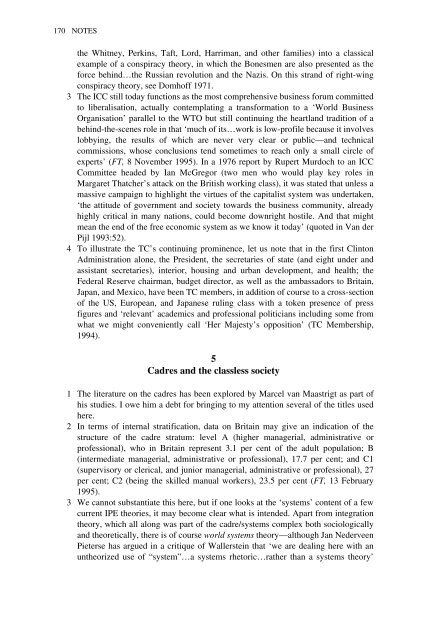van der pijl-transnational classes and IR
van der pijl-transnational classes and IR
van der pijl-transnational classes and IR
- No tags were found...
You also want an ePaper? Increase the reach of your titles
YUMPU automatically turns print PDFs into web optimized ePapers that Google loves.
170 NOTESthe Whitney, Perkins, Taft, Lord, Harriman, <strong>and</strong> other families) into a classicalexample of a conspiracy theory, in which the Bonesmen are also presented as theforce behind…the Russian revolution <strong>and</strong> the Nazis. On this str<strong>and</strong> of right-wingconspiracy theory, see Domhoff 1971.3 The ICC still today functions as the most comprehensive business forum committedto liberalisation, actually contemplating a transformation to a ‘World BusinessOrganisation’ parallel to the WTO but still continuing the heartl<strong>and</strong> tradition of abehind-the-scenes role in that ‘much of its…work is low-profile because it involveslobbying, the results of which are never very clear or public—<strong>and</strong> technicalcommissions, whose conclusions tend sometimes to reach only a small circle ofexperts’ (FT, 8 November 1995). In a 1976 report by Rupert Murdoch to an ICCCommittee headed by Ian McGregor (two men who would play key roles inMargaret Thatcher’s attack on the British working class), it was stated that unless amassive campaign to highlight the virtues of the capitalist system was un<strong>der</strong>taken,‘the attitude of government <strong>and</strong> society towards the business community, alreadyhighly critical in many nations, could become downright hostile. And that mightmean the end of the free economic system as we know it today’ (quoted in Van <strong>der</strong>Pijl 1993:52).4 To illustrate the TC’s continuing prominence, let us note that in the first ClintonAdministration alone, the President, the secretaries of state (<strong>and</strong> eight un<strong>der</strong> <strong>and</strong>assistant secretaries), interior, housing <strong>and</strong> urban development, <strong>and</strong> health; theFe<strong>der</strong>al Reserve chairman, budget director, as well as the ambassadors to Britain,Japan, <strong>and</strong> Mexico, have been TC members, in addition of course to a cross-sectionof the US, European, <strong>and</strong> Japanese ruling class with a token presence of pressfigures <strong>and</strong> ‘rele<strong>van</strong>t’ academics <strong>and</strong> professional politicians including some fromwhat we might conveniently call ‘Her Majesty’s opposition’ (TC Membership,1994).5Cadres <strong>and</strong> the classless society1 The literature on the cadres has been explored by Marcel <strong>van</strong> Maastrigt as part ofhis studies. I owe him a debt for bringing to my attention several of the titles usedhere.2 In terms of internal stratification, data on Britain may give an indication of thestructure of the cadre stratum: level A (higher managerial, administrative orprofessional), who in Britain represent 3.1 per cent of the adult population; B(intermediate managerial, administrative or professional), 17.7 per cent; <strong>and</strong> C1(supervisory or clerical, <strong>and</strong> junior managerial, administrative or professional), 27per cent; C2 (being the skilled manual workers), 23.5 per cent (FT, 13 February1995).3 We cannot substantiate this here, but if one looks at the ‘systems’ content of a fewcurrent IPE theories, it may become clear what is intended. Apart from integrationtheory, which all along was part of the cadre/systems complex both sociologically<strong>and</strong> theoretically, there is of course world systems theory—although Jan Ne<strong>der</strong>veenPieterse has argued in a critique of Wallerstein that ‘we are dealing here with anuntheorized use of “system”…a systems rhetoric…rather than a systems theory’


